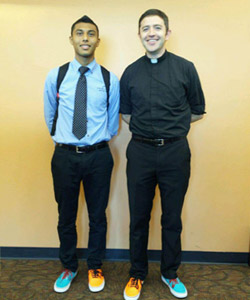
| Support the Midwest Jesuits |
| Send a message of encouragement to Joe Simmons, SJ |
| Not a subscriber? Stay connected with our e-newsletters |
July 23, 2014 - Joe Simmons, SJ, who entered the Jesuits in 2006, just completed his three years of regency: two years of teaching at Cristo Rey Jesuit High School in Minneapolis, and one year of work at Creighton University in Omaha. Joe, a native of Milwaukee, is spending part of this summer in Malta with the Jesuit Refugee Service, doing pastoral work with detained refugees from Eritrea, Nigeria, and Somalia. In August, Joe begins his final three years of theology studies at Boston College. He is excited for ordination to the priesthood in June 2017.
Here Come
the Men in Black.
I
remember when I first heard it. A group of Jesuits were recounting unusual
encounters with people -- in restaurants, on airplanes, or just walking down the
street. One middle-aged priest pointed to his Roman collar and said, "See
this? It's a crazy magnet!" I was shocked, surprised, and a
little saddened. Weren't we here to serve, even those who might seem a little
'crazy'?
This all came back to me recently -- twice
in one day, in fact. In June I helped lead a trip to Classical Rome for
students from one of our Jesuit high schools. I packed my usual summer-abroad
gear; but this time, I carefully folded in black slacks and a cleric shirt --
we were going to the Eternal City, after all. On day two, we headed to a papal
audience in St. Peter's Square, where fellow scholastic Bryan Norton and I
slow-roasted in black as we welcomed Pope Francis' arrival. "Clerics was a
bad choice," I thought, envying His Holiness's white upgrade.
After a climb to the top of the world's largest dome, we corralled our students
out of St. Peter's imposing facade. Suddenly a distracted young woman came up
to me, pulling nervously at her hair. "Um, father, do you speak
English?" I could feel my scalp grow taut, fearful that (1) I had overshot
by dressing like a priest, and (2) that her next words would prove the Crazy
Magnet theory true.
"Yes, I speak English," I sheepishly offered. At this her face and
shoulders heaved a sigh of relief. As it turned out, this young woman, Megan,
was actually a high school student from Omaha, on the last leg of a European
tour. She had been taking pictures outside of St. Peter's, wandered from her
group, and now she was lost and panicked. All she had was an emergency contact
card and a sense that two guys in clerics were a safe place to start.
We tracked down her group leader by cell phone, who was quite relieved. In the
meantime, we calmed her by asking about school, home, etc. It turns out that the
Jesuits I lived with regularly say Mass at her school. Here I was, a Jesuit
scholastic teaching in Omaha...meeting a poor, banished child of Omaha halfway
across the world. Crazy coincidence?
Satisfied that we had done our good deed for the day, Bryan and I caught up
with our group to head to the Vatican Museum. En route, a middle-aged woman ran
up to me. "Padre, Padre! Aiuto, per favore!" -- "Help, Father,
please!" Seeing no stout Italian priest around me to duck behind, I
gathered that she wanted me, the man dressed in black clerics, to bless her.
You know, like a priest would.
I probed my small store of Italian apologies: "It displease me, I am
already not a priest, but a seminarist." This woman, Maria, was
unphased. Grammar notwithstanding, she wanted my blessing. I pulled out a trick
that a wise old Jesuit, Fr. Ambrose, taught me years before in northeast India.
"Preghiamo insieme?" I offered. "Let's pray together?"
"Si, si, padre!" Again with the padre.
And so we prayed -- I stumbled through prayers for Maria in Italian, and she
repeated them with a smile, gently echoing everything but my gaffs. My hands
were on her elbows, and hers gripped my shoulders, like an awkward kid's first
slow dance. Our student group had stopped to look back at me, wondering what
'magical healings' Padre Simmons was performing now.
I felt...sheepish. Humbled. And in spite of my sheepish gaffs, I felt like a
priest. And all this happened because I looked trustworthy in clerics.
Crazy, indeed.
* * *
Larry Gillick, SJ says that it takes a long time to make a Jesuit. And I doubt that the outfit a fine priest doth make. Yet that hot day in Rome reminded me that this long road of Jesuit formation -- which began in 2006 for our class of seven -- does have an end goal. I'm beginning to see how this Jesuit life -- as a novice in St. Paul, during philosophy studies in Chicago, while teaching in Minneapolis and Omaha, and as a student again in theology studies -- slowly forms us to become priests. Our lives are blessed with unexpected gifts -- the likes of Megan and Maria -- who teach us what it means to be an available, loving priest. It seems counterintuitive, crazyeven, that the most joyful Jesuits I know live as if their life, time, and talents were never theirs in the first place, so why cling to them? My hope is that when we Jesuits put on clerics, we say to the world, "I am here for you; how can I help?"
* * *
It's as if the collar is a crazy magnet, after all.
To read more Heart on Fire profiles, click here.